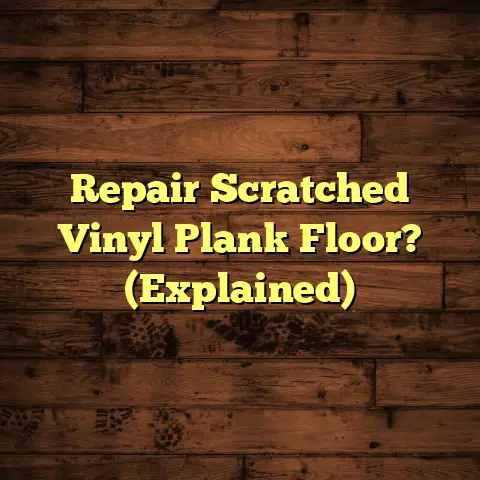Replace Laminate Section? (9 Steps To Fix It Now!)
Yeah, me too.
More often than not, it’s the little things that throw us off balance, and trust me, a damaged floor can be a real mood killer.
As a flooring contractor with over 15 years of experience, I can tell you that your flooring plays a HUGE role in how comfortable and inviting your home feels.
Laminate flooring has become super popular, and it’s easy to see why.
It’s affordable, looks great, and is pretty easy to keep clean.
But let’s be real, life happens.
Scratches, dents, water damage – these things can turn a beautiful laminate floor into an eyesore.
And that’s where I come in!
I’m going to walk you through a simple, step-by-step process for replacing a damaged section of laminate flooring.
No need to call in the pros (unless you really want to!).
With a bit of elbow grease and my guidance, you can restore the comfort and beauty of your home in no time.
Let’s get started!
Understanding Laminate Flooring
So, what exactly is laminate flooring?
Think of it as a clever imitation of real wood, tile, or stone.
It’s made up of several layers, all pressed together:
-
Wear Layer: This is the top layer, a clear coating that protects against scratches, stains, and fading.
-
Decorative Layer: This is the layer that gives laminate its realistic look. It’s a high-resolution photograph of wood, tile, or stone.
-
Core Layer: This is the thickest layer, usually made of high-density fiberboard (HDF) or medium-density fiberboard (MDF). It provides stability and impact resistance.
-
Backing Layer: This bottom layer provides moisture resistance and helps to prevent warping.
Why Choose Laminate?
I’ve installed miles of laminate flooring over the years, and here’s why my clients (and I!) love it:
-
Durability: That wear layer is tough! Laminate can withstand a lot of foot traffic.
-
Affordability: It’s much cheaper than hardwood or tile. Plus, it’s easy to install yourself, saving on labor costs.
-
Easy Installation: Most laminate flooring uses a “click-lock” system, making it a breeze to install.
-
Variety of Designs: You can find laminate that looks like just about any type of wood, tile, or stone.
Common Laminate Problems
Even though laminate is durable, it’s not invincible.
Here are some common issues that can lead to needing a replacement:
-
Scratches: Furniture, pets, and even just regular foot traffic can cause scratches.
-
Water Damage: Laminate isn’t waterproof. Spills need to be cleaned up quickly to prevent swelling and warping.
-
Buckling: This happens when moisture gets underneath the laminate, causing it to expand and buckle.
-
Dents: Heavy objects can dent the surface of the laminate.
When these problems happen, replacing the damaged section is often the best way to restore your floor.
Assessing the Damage
Okay, so you’ve got a problem spot on your laminate floor.
Before you start ripping things up, let’s take a closer look.
What to Look For
Here’s what I look for when assessing laminate damage:
-
Scratch Depth: Are the scratches just on the surface, or do they go through the wear layer?
Surface scratches can often be buffed out with a scratch repair kit.
-
Water Damage: Is the laminate swollen or discolored?
If so, water has likely penetrated the core layer, and replacement is needed.
-
Buckling: How severe is the buckling?
A slight buckle might be fixable, but a large buckle usually means the plank needs to be replaced.
-
Dents: How deep are the dents?
Shallow dents might be hidden with furniture, but deep dents will need to be addressed.
Repair or Replace?
Here’s a general rule of thumb:
-
Repair: Minor scratches, small surface stains.
-
Replace: Water damage, deep scratches, buckling, significant dents.
Tools for Assessment
You don’t need a ton of fancy tools, but these will help:
-
Flashlight: Shine it at an angle to highlight scratches and dents.
-
Moisture Meter: If you suspect water damage, this will tell you how much moisture is present.
- Note: A decent moisture meter can be found for around $30-$50 at most hardware stores.
-
Magnifying Glass: Helps to see small scratches and damage.
-
Camera: Take pictures of the damage to document it for insurance purposes or when buying replacement planks.
Pro Tip
One thing I always tell my clients is to check for spare planks.
When the floor was originally installed, there might be extra planks stored away.
If you have a spare, replacing the damaged section is much easier because you’ll have an exact match.
Preparing for Replacement
Alright, you’ve assessed the damage and decided that replacement is the way to go.
Now, let’s get prepared!
Clearing the Area
First things first, clear the area around the damaged plank.
Move furniture, rugs, and anything else that might get in the way.
Give yourself plenty of room to work.
Tools and Materials
Here’s what you’ll need:
-
Replacement Laminate Plank: Make sure it’s an exact match in terms of color, thickness, and locking mechanism.
-
Pry Bar: For gently lifting the damaged plank.
-
Utility Knife: For scoring and cutting the laminate.
-
Measuring Tape: To measure the damaged area and the new plank.
-
Tapping Block and Hammer: To ensure a snug fit when installing the new plank.
-
Safety Glasses: Protect your eyes from debris.
-
Gloves: Protect your hands.
-
Dust Mask: Avoid breathing in dust and debris.
-
Vacuum Cleaner: For cleaning up after the job is done.
Measuring is Key
Accurate measurements are crucial.
Measure the length and width of the damaged plank.
Also, measure the distance from the wall to the damaged plank.
This will help you determine how much of the new plank you need to cut.
Acclimation
Before you start installing the new plank, let it acclimate to the room’s temperature and humidity for at least 48 hours.
This will prevent it from expanding or contracting after installation, which can lead to buckling.
Safety First
Always wear safety glasses, gloves, and a dust mask when working with laminate flooring.
Laminate dust can be irritating to the eyes and lungs.
Removing the Damaged Section
Okay, time to get down to business!
Removing the damaged section is probably the trickiest part of the process.
Take your time and be careful not to damage the surrounding planks.
Step 1: Identify the Starting Point
Look for the easiest access point to remove the damaged plank.
This is usually along a wall or at the edge of the room.
Step 2: Detach the Damaged Plank
Use a utility knife to score along the edges of the damaged plank, where it meets the adjacent planks.
This will help to break the seal and make it easier to remove.
Then, use a pry bar to gently lift the damaged plank.
Work slowly and carefully, prying up a little bit at a time.
If the plank is glued down, you may need to use a heat gun to soften the adhesive.
Step 3: Remove Adjacent Planks (If Necessary)
Sometimes, you’ll need to remove a few adjacent planks to get the damaged plank out.
If so, use the same technique as above: score the edges with a utility knife and gently pry up the planks.
Remember to label the planks so you know where they go when you reinstall them.
Step 4: Clean the Subfloor
Once you’ve removed the damaged plank, clean the subfloor thoroughly.
Remove any debris, dust, or adhesive residue.
Inspect the subfloor for any signs of damage, such as moisture or rot.
If you find any damage, repair it before installing the new plank.
Tips for Avoiding Damage
-
Use a sharp utility knife: A dull blade can tear the laminate and damage the surrounding planks.
-
Work slowly and carefully: Don’t force anything.
-
Use a tapping block: This will help you to avoid damaging the edges of the planks when you’re prying them up.
-
Protect the surrounding planks: Use a piece of cardboard or plywood to protect the surrounding planks from scratches and dents.
My Experience
I remember one time, I was replacing a damaged section of laminate in a customer’s kitchen.
The plank was glued down, and I was having a hard time getting it up.
I got a little impatient and started yanking on it, and I ended up damaging one of the surrounding planks.
I had to replace that one too!
That’s why I always tell people to take their time and be careful.
It’s better to spend a little extra time and do it right than to rush and make mistakes.
Preparing the New Laminate Plank
Now that you’ve removed the damaged section, it’s time to prepare the new laminate plank.
Color Matching
The most important thing is to make sure that the new plank is an exact match in terms of color and pattern.
If you don’t have a spare plank, take a piece of the damaged plank to the store with you when you buy the replacement.
Thickness and Locking Mechanism
Also, make sure that the new plank is the same thickness as the existing flooring and that it has the same type of locking mechanism.
If the thickness is different, the new plank will stick up or sink down, creating an uneven surface.
If the locking mechanism is different, you won’t be able to connect the new plank to the existing flooring.
Cutting the New Plank
If you need to cut the new plank to size, use a circular saw or a laminate cutter.
A circular saw will give you a clean, straight cut, but it can be messy.
A laminate cutter is designed specifically for cutting laminate flooring, and it produces a very clean cut with minimal dust.
Pro Tip
When cutting the new plank, always cut it slightly larger than the opening.
You can always trim it down later if necessary.
It’s much harder to add material than it is to remove it.
Installing the New Laminate Section
Alright, the moment of truth!
Installing the new laminate section can be easy if you take your time.
Step 1: Position the New Plank
Carefully position the new plank in the opening.
Make sure that it’s aligned with the surrounding planks.
Step 2: Lock the New Plank
Use a tapping block and hammer to lock the new plank into the existing flooring system.
Place the tapping block against the edge of the new plank and gently tap it with the hammer.
Work your way around the plank, tapping it in until it’s securely locked in place.
Step 3: Check for Gaps
Check for any gaps between the new plank and the surrounding planks.
If you find any gaps, use the tapping block and hammer to close them.
Step 4: Make Adjustments
If the new plank doesn’t fit perfectly, you may need to make some adjustments.
Use a utility knife or a laminate cutter to trim the edges of the plank until it fits snugly in place.
Best Practices
-
Work slowly and carefully: Don’t force anything.
-
Use a tapping block: This will help you to avoid damaging the edges of the planks.
-
Check for gaps: Make sure that there are no gaps between the new plank and the surrounding planks.
-
Make adjustments as needed: Don’t be afraid to trim the edges of the plank until it fits perfectly.
My Mistake
I remember one time, I was installing a new laminate section in a customer’s living room.
I was in a hurry, and I didn’t check for gaps.
After I finished the job, I noticed a small gap between the new plank and the surrounding planks.
It wasn’t a huge gap, but it was noticeable.
I had to remove the new plank and reinstall it, taking the time to make sure that there were no gaps.
That’s why I always tell people to check for gaps before they finish the job.
It’s much easier to fix a gap before you’ve finished than it is to fix it afterward.
Final Touches and Cleaning Up
You’re almost there!
Just a few more steps to go.
Ensuring Secure Planks
Once you’ve installed the new plank, double-check to make sure that all the planks are securely in place.
Walk around on the new section of flooring to make sure that it feels solid and stable.
Cleaning Up
Use a vacuum cleaner to clean up any debris or dust caused by the installation.
Wipe down the area with a damp cloth to remove any remaining dirt or grime.
Allowing Time to Settle
Allow the newly installed section to settle for at least 24 hours before placing furniture back in the area.
This will give the adhesive time to cure and the planks time to adjust to the room’s temperature and humidity.
Inspect
Finally, inspect the new section of flooring to make sure that it looks good and that there are no problems.
If you find any problems, address them immediately.
Pro Tip
After you’ve installed the new section of flooring, apply a laminate floor cleaner to protect the surface and keep it looking its best.
Maintaining Your Laminate Flooring
You’ve done the hard work of replacing the damaged section, now let’s keep your laminate floor looking great for years to come!
Regular Cleaning
Sweep or vacuum your laminate floor regularly to remove dirt and debris.
Use a damp mop with a laminate floor cleaner to clean the floor.
Avoid using excessive water, as this can damage the laminate.
Protective Measures
Place mats at entrances to trap dirt and debris.
Use furniture pads under the legs of furniture to prevent scratches.
Avoid wearing shoes with high heels or cleats on the laminate floor.
Humidity Control
Maintain a consistent humidity level in your home to prevent the laminate from expanding or contracting.
Use a humidifier or dehumidifier as needed.
Addressing Spills
Clean up spills immediately to prevent water damage.
Use a soft cloth to blot up the spill.
Avoid rubbing the spill, as this can spread it.
My Regret
I once had a client who installed a beautiful laminate floor in their kitchen.
They loved the way it looked, but they didn’t take care of it properly.
They never swept or vacuumed the floor, and they often spilled things on it without cleaning them up.
Over time, the floor became scratched, stained, and damaged.
Eventually, they had to replace the entire floor.
That’s why I always emphasize the importance of proper maintenance.
A little bit of care can go a long way in extending the life of your laminate floor.
Conclusion
Wow, you made it!
You’ve successfully replaced a damaged section of laminate flooring.
Let’s recap the key steps:
-
Assess the damage.
-
Prepare for replacement.
-
Remove the damaged section.
-
Prepare the new laminate plank.
-
Install the new laminate section.
-
Final touches and cleaning up.
-
Maintain your laminate flooring.
Addressing flooring issues promptly can restore comfort and beauty to your home.
Don’t let a damaged floor ruin your day.
Take action and reclaim your space!
There’s a real sense of satisfaction that comes from completing a DIY project, especially one that makes such a big difference in the look and feel of your home.
So, go ahead and give it a try!
I hope this guide has been helpful.
Now go enjoy your beautiful, newly restored laminate floor!





